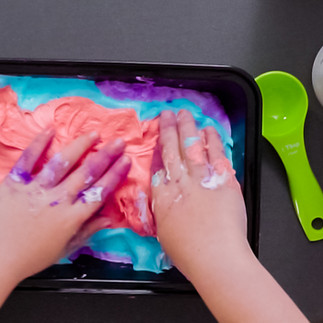Sensory Processing in Toddlers: Is This Normal?
- Taryn van der Westhuizen

- Jul 14
- 3 min read
Updated: Aug 10
At Nurtured Growth Therapy, we often meet parents who wonder, “Is this just a quirky toddler moment, or something more?” Sensory processing in toddlers can be puzzling and sometimes overwhelming. However, it’s also a beautiful window into how your little one experiences the world.
Let’s explore some common sensory behaviours, how to tell the difference between preferences and challenges, and practical ways you can support your child at home.
Understanding Sensory Processing in Toddlers
Sensory processing is how our brains interpret information from our senses. For toddlers, this process is still developing. They learn through touch, sound, movement, taste, and smell. Many behaviours that might seem odd are part of typical development. You might notice:
Spinning around and around without getting dizzy.
Avoiding certain textures, like mushy foods or sticky hands.
Covering ears when a loud sound occurs.
Seeking pressure, like climbing under cushions or squeezing into tight spaces.
Running everywhere or having trouble sitting still.
Fascination with water, lights, or sounds.
Sound familiar? These are often signs your toddler is processing sensory input in their own unique way.
Common Sensory Behaviours in Toddlers
Recognising Sensory Preferences
It’s important to remember that every child has sensory preferences—just like adults! Some of us love spicy food, while others can’t stand the feel of scratchy clothes. The same goes for toddlers. They may gravitate towards certain activities or avoid others based on their sensory preferences.
Identifying Sensory Challenges
However, if your child’s sensory responses:
Interfere with everyday activities (e.g., dressing, mealtime, sleep),
Cause meltdowns or avoidant behaviours often,
Make social situations tricky or overwhelming,
Or seem unusually intense or frequent...
...they may be experiencing sensory processing challenges rather than just preferences.
This doesn’t mean something is “wrong.” It simply means their brain processes information differently. With the right support, they can thrive.
Simple Home Strategies to Support Sensory Needs
Here are some playful, nurturing ways to help your toddler regulate their sensory world at home:
Create a calm corner with soft pillows, gentle lights, and quiet toys.
Offer heavy work play like pushing laundry baskets, animal walks, or carrying groceries.
Use rhythmic activities like swinging, bouncing, or rocking for soothing.
Let them explore textures at their own pace—think playdough, water play, or sensory bins.
Try firm, slow touch rather than light tickles for children sensitive to touch.
Keep routines predictable—this helps reduce sensory overload.
Most importantly, follow your child’s lead. They’re the experts of their own bodies.
When to Consult an Occupational Therapist
If you’re feeling unsure, overwhelmed, or just want a clearer understanding of your toddler’s sensory needs, an occupational therapist (OT) can help.
We work alongside families to:
Observe sensory patterns.
Identify strengths and challenges.
Create tailored strategies that support daily life.
At Nurtured Growth Therapy, our approach is gentle, play-based, and built around your family’s unique rhythm.
Curious to Learn More?
If you want to explore more about sensory processing, consider reading “The Out-of-Sync Child” by Carol Kranowitz. It is a classic and compassionate guide to understanding sensory processing differences.
You can also check out “Raising a Sensory Smart Child” by Lindsey Biel & Nancy Peske, which offers strategies for daily life and navigating sensory needs across home and school settings.
Lastly, “Sensational Kids” by Lucy Jane Miller is based on research and clinical experience. This book supports families in understanding sensory challenges and creating a supportive environment.
Let’s Connect!
If you have questions or want to discuss your little one’s sensory world, reach out to us. We’re here to listen, support, and grow together.









